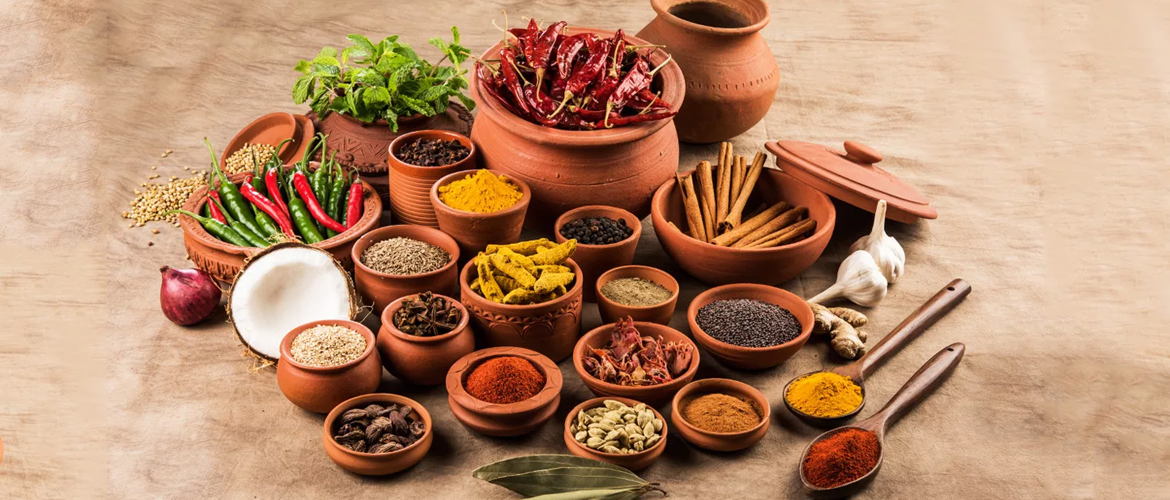Indian spices are an essential ingredient in Indian cuisine, known for their aroma and complex flavours. But did you know the alternative use of Indian spices that only our grandmas might know about? Here are a few lesser-known uses of Indian spices, not only the essential Indian herbs but also the rarely used ones.
Alternative use of the seven main Indian spices
What are the 7 main Indian spices? There are certain spices that are considered the main ingredients in many Indian dishes. These are often referred to as the “Seven Spices” or “Seven Masalas” in Indian cooking. Here are the health benefits and alternative use of Indian spices.
-
Turmeric (Haldi)
This spice has been used in Indian traditional medicine for centuries. Turmeric is a bright yellow spice with a slightly bitter, earthy flavour. It is used in many Indian dishes for its colour and flavour and is also known for its health benefits. Turmeric is the best element for wound healing. It has natural antibacterial properties that can help prevent infection and promote healing. Applying a paste of turmeric and water on minor cuts and burns can help soothe the wound and promote faster healing.
-
Fennel (Large Cumin)
Cumin is a spice with a warm, earthy, and slightly bitter flavour. It is used in many Indian dishes and is a key ingredient in many spice blends. In addition, these seeds are commonly used as a mouth freshener after meals in India. Drinking fennel tea or chewing on fennel seeds can help soothe the digestive system and relieve bloating and gas.
-
Coriander (Dhania)
Coriander is a popular herb used in Indian cooking, but it can also be used for skin care. Applying a paste of coriander leaves and water to the face can help soothe the skin and prevent breakouts with its antioxidants and antibacterial properties.
-
Fenugreek (Methi)
Fenugreek seeds and leaves have a slightly sweet, nutty flavour. They are used in many Indian dishes, including curries and spice blends. It is also used for its hair growth-promoting properties. Applying a paste of fenugreek seeds and water to the scalp can help stimulate hair growth and prevent hair loss.
-
Cardamom (Elaichi)
Cardamom has a sweet, floral, and slightly spicy flavour. It is used in many Indian dishes, including desserts, chai tea, and spice blends. The aroma of the spice can help relax the mind and body. Adding a few pods of cardamom to your bathwater can create a calming and refreshing bath experience and help alleviate stress and anxiety.
-
Mustard (Sarso)
Mustard seeds have a pungent, slightly bitter flavour. They are used in many Indian pickles, chutneys, curries, and spice blends. The seeds can also be used for pain relief. Massaging mustard oil onto the affected area can provide relief and promote healing.
-
Black Pepper
Black pepper is a common spice used in Indian cooking, known for its spicy flavour. It can also help relieve congestion and promote respiratory health. Adding a pinch of black pepper to hot water and inhaling the steam can help clear the nasal passages and promote easier breathing.
These seven spices form the basis of many Indian dishes. However, there are some unusual Indian spices you’re probably not using in many cooking recipes.
Unusual Indian spices you’re probably not using
While many people are familiar with common Indian spices like cumin, turmeric, and coriander, there are many more unusual spices that are often overlooked. These lesser-known spices can add unique and exciting flavours to your cooking, and some even have potential health benefits. From the floral aroma of asafoetida to the fruity notes of amchur, there are many unusual Indian spices that you may not be using but are worth exploring. Continue reading to know these unique spices’ names.
-
Asafoetida (Hing)
Do you know what is the stinky Indian spice? The answer is Asafoetida which is a resin obtained from the roots of Ferula plants. The spice is also known as Devil’s Dung due to its pungent smell and its texture. Asafoetida has been used for centuries in vegetarian dishes to improve digestion. Consume a pinch of asafoetida mixed with hot water to alleviate digestive issues like gas, bloating, and constipation.
-
Ajwain (Carom Seeds)
Ajwain is a spice with a strong, pungent flavour and a slightly bitter taste. It is commonly used in Indian bread (paratha) and many other dishes to improve digestion. Ajwain is also believed to have weight loss benefits, as it helps boost metabolism.
-
Amchoor (Dried Mango Powder)
Amchoor is made from dried and ground unripe green mangoes. It has a sour and tangy flavour and is used in many Indian dishes to add a sour note to the dish. The powder is believed to have immune-boosting properties due to its high vitamin C content. Amchoor may help regulate blood sugar levels. Studies have shown that it can help reduce the glycemic index of foods, which may be beneficial for managing diabetes and preventing blood sugar spikes.
-
Mace (Javitri)
Mace is the outer covering of the nutmeg seed and has a slightly sweet and nutty flavour. It is used in many Indian dishes, including desserts, and meat curries. It should be used in moderation as high usage can cause adverse effects. Mace is a good source of minerals and has been traditionally used as a digestive aid. It contains compounds that have anti-inflammatory properties.
Bottom Line
In conclusion, alternative use of Indian spices beyond their culinary usefulness can benefit our health and well-being. These natural remedies have been passed down through generations and are still used by our grandmas today. So, the next time you’re cooking with Indian spices, try experimenting with some of these lesser-known spices which have many other benefits beyond just adding flavour to your food.

